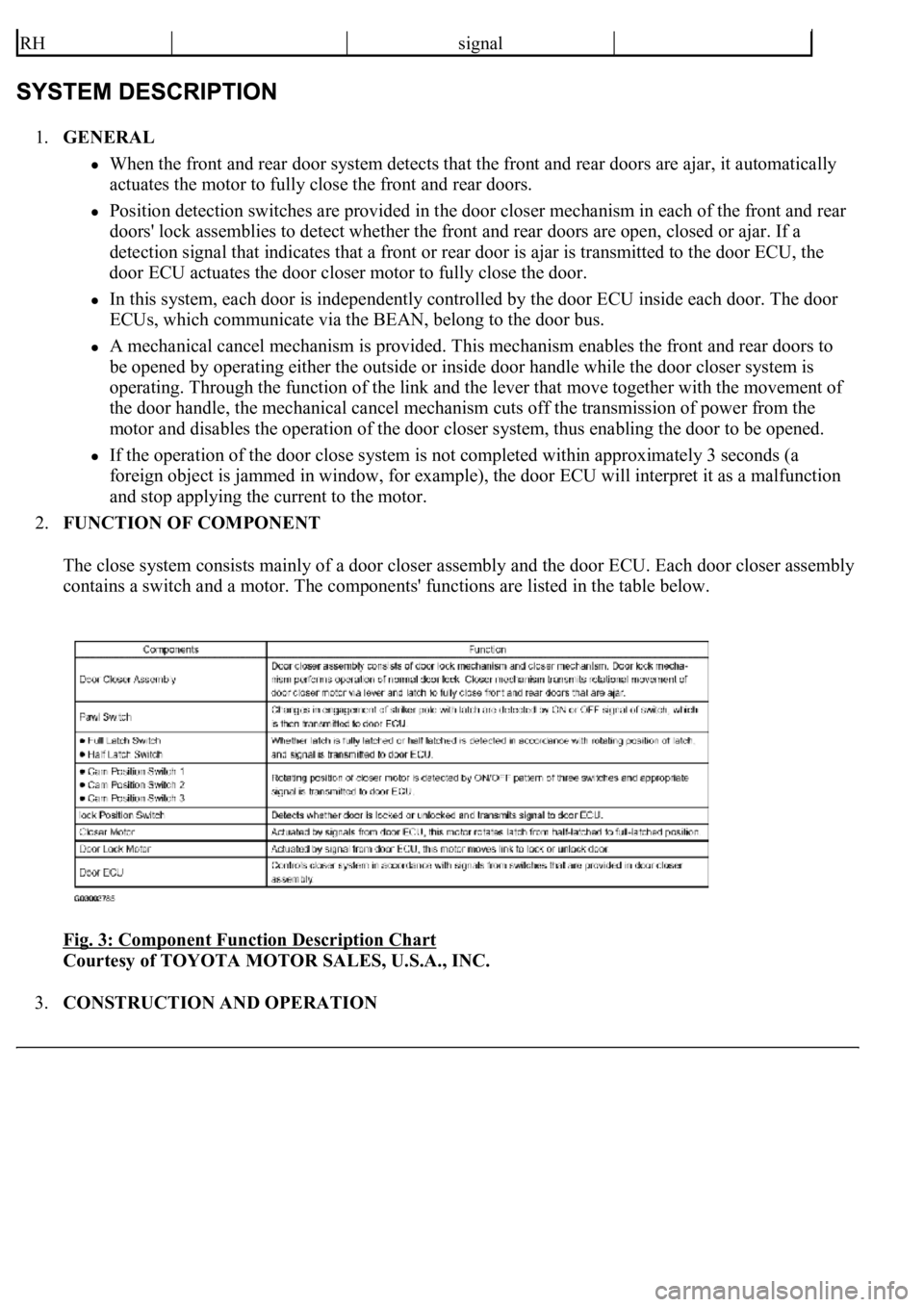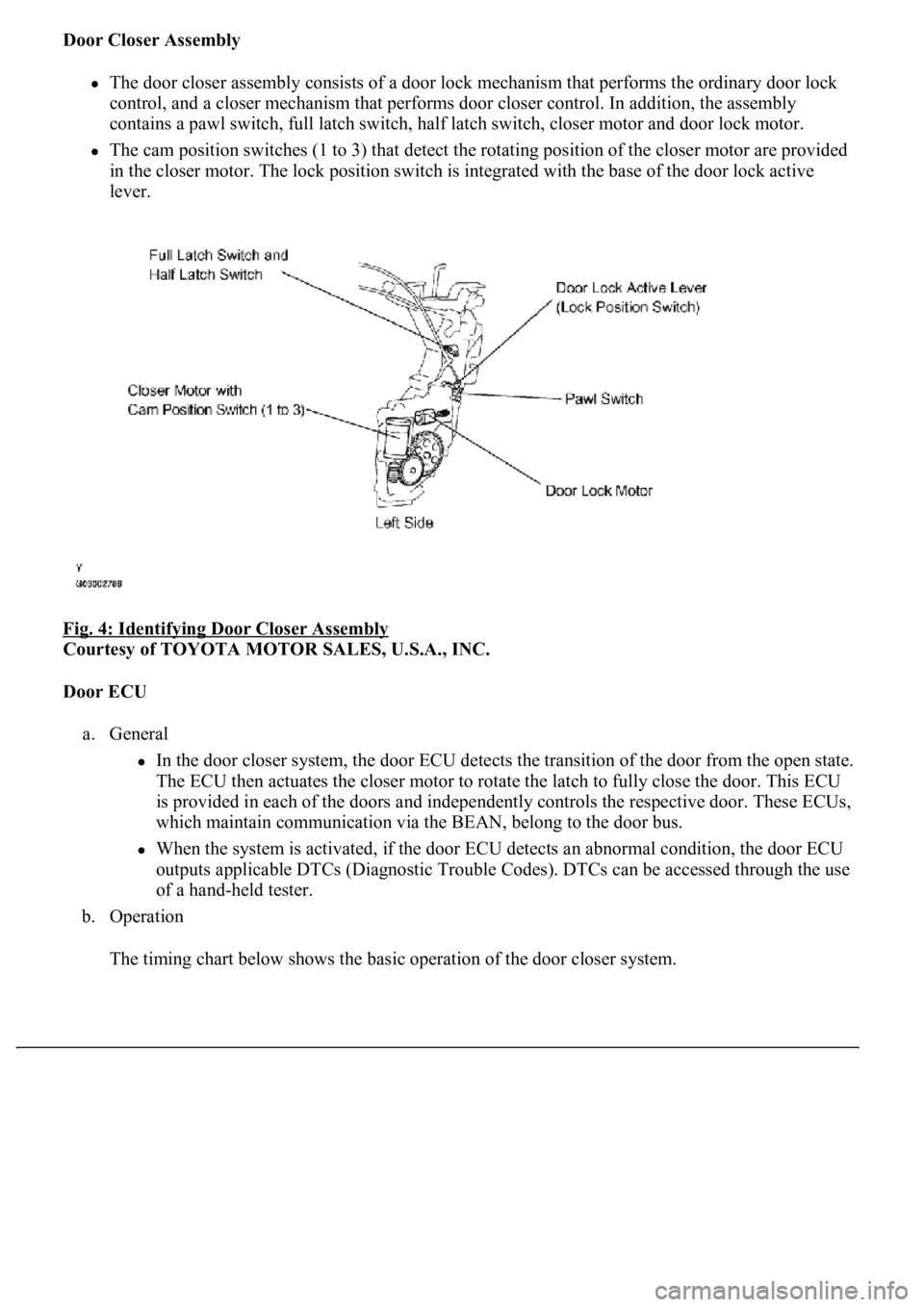Page 2174 of 4500
Fig. 134: Identifying Rear Differential Mount Direction Mark
Courtesy of TOYOTA MOTOR SALES, U.S.A., INC.
b. Support the rear differential carrier assembly with a jack and wooden block.
c. Temporally install the lower mount stoppers and 2 new front side set bolts.
Page 2181 of 4500

1.GENERAL
When the front and rear door system detects that the front and rear doors are ajar, it automatically
actuates the motor to fully close the front and rear doors.
Position detection switches are provided in the door closer mechanism in each of the front and rear
doors' lock assemblies to detect whether the front and rear doors are open, closed or ajar. If a
detection signal that indicates that a front or rear door is ajar is transmitted to the door ECU, the
door ECU actuates the door closer motor to fully close the door.
In this system, each door is independently controlled by the door ECU inside each door. The door
ECUs, which communicate via the BEAN, belong to the door bus.
A mechanical cancel mechanism is provided. This mechanism enables the front and rear doors to
be opened by operating either the outside or inside door handle while the door closer system is
operating. Through the function of the link and the lever that move together with the movement of
the door handle, the mechanical cancel mechanism cuts off the transmission of power from the
motor and disables the operation of the door closer system, thus enabling the door to be opened.
If the operation of the door close system is not completed within approximately 3 seconds (a
foreign object is jammed in window, for example), the door ECU will interpret it as a malfunction
and stop applying the current to the motor.
2.FUNCTION OF COMPONENT
The close system consists mainly of a door closer assembly and the door ECU. Each door closer assembly
contains a switch and a motor. The components' functions are listed in the table below.
Fig. 3: Component Function Description Chart
Courtesy of TOYOTA MOTOR SALES, U.S.A., INC.
3.CONSTRUCTION AND OPERATION
RHsignal
Page 2182 of 4500

Door Closer Assembly
The door closer assembly consists of a door lock mechanism that performs the ordinary door lock
control, and a closer mechanism that performs door closer control. In addition, the assembly
contains a pawl switch, full latch switch, half latch switch, closer motor and door lock motor.
The cam position switches (1 to 3) that detect the rotating position of the closer motor are provided
<004c005100030057004b004800030046004f0052005600480055000300500052005700520055001100030037004b00480003004f00520046004e0003005300520056004c0057004c0052005100030056005a004c00570046004b0003004c00560003004c00
5100570048004a005500440057004800470003005a004c0057[h the base of the door lock active
lever.
Fig. 4: Identifying Door Closer Assembly
Courtesy of TOYOTA MOTOR SALES, U.S.A., INC.
Door ECU
a. General
In the door closer system, the door ECU detects the transition of the door from the open state.
The ECU then actuates the closer motor to rotate the latch to fully close the door. This ECU
is provided in each of the doors and independently controls the respective door. These ECUs,
which maintain communication via the BEAN, belong to the door bus.
When the system is activated, if the door ECU detects an abnormal condition, the door ECU
outputs applicable DTCs (Diagnostic Trouble Codes). DTCs can be accessed through the use
of a hand-held tester.
b. Operation
The timin
g chart below shows the basic operation of the door closer system.
Page 2184 of 4500
Fig. 6: Cancel Function Diagram
Courtesy of TOYOTA MOTOR SALES, U.S.A., INC.
HINT:
If the child lock of a rear door is engaged, it cannot be canceled by operating the inside door
handle.
d. Closer Motor and Cam Position Switch
Three cam position switches (1 to 3) are provided in the closer motor. In accordance with these
switches' ON/OFF patterns, the closer motor's rotating positions are determined in the 3 segments
of the motor's movin
g range.
Page 2201 of 4500
OK: "ON" (cam position switch 1 to 3 is ON) appears on the screen.
NG: Go to step 2
OK: REPLACE DRIVER DOOR ECU
2.CHECK FRONT DOOR LOCK ASSY LH (CAM POSITION SWITCH)
a. Measure the switch resistance.
Standard:
Fig. 28: Terminals Resistance Reference Chart
Courtesy of TOYOTA MOTOR SALES, U.S.A., INC.
CAM
POS
SW1Cam position switch 1 (OFF/ON)Refer to system description of closer
motor and position switch (SEE
SYSTEM DESCRIPTION
)
-
Page 2202 of 4500
Fig. 29: Checking Front Door Lock Assy LH (Cam Position Switch)
Courtesy of TOYOTA MOTOR SALES, U.S.A., INC.
Refer to the system description for the ON/OFF patterns of the cam position switch (SEE SYSTEM
DESCRIPTION ).
NG: REPLACE FRONT DOOR LOCK ASSY LH
OK: REPLACE DRIVER DOOR ECU
CIRCUIT DESCRIPTION
This DTC is output when a malfunction is detected in the cam position circuit.
Page 2204 of 4500
OK: "ON" (cam position switch 1 to 3 is ON) appears on the screen.
NG: Go to step 2
OK: REPLACE PASSENGER DOOR ECU
2.CHECK FRONT DOOR LOCK ASSY RH (CAM POSITION SWITCH)
Standard:
Fig. 32: Terminals Resistance Reference Chart
Courtesy of TOYOTA MOTOR SALES, U.S.A., INC.
CAM
POS SW1Cam position switch 1
(OFF/ON)Refer to system description of closer
motor and position switch (SEE
SYSTEM DESCRIPTION
)
-
Page 2205 of 4500
Fig. 33: Checking Front Door Lock Assy RH (Cam Position Switch)
Courtesy of TOYOTA MOTOR SALES, U.S.A., INC.
Refer to the system description for the ON/OFF patterns of the cam position switch (SEE SYSTEM
DESCRIPTION ).
NG: REPLACE FRONT DOOR LOCK ASSY RH
OK: REPLACE PASSENGER DOOR ECU
CIRCUIT DESCRIPTION
This DTC is output when a malfunction is detected in the cam position circuit.